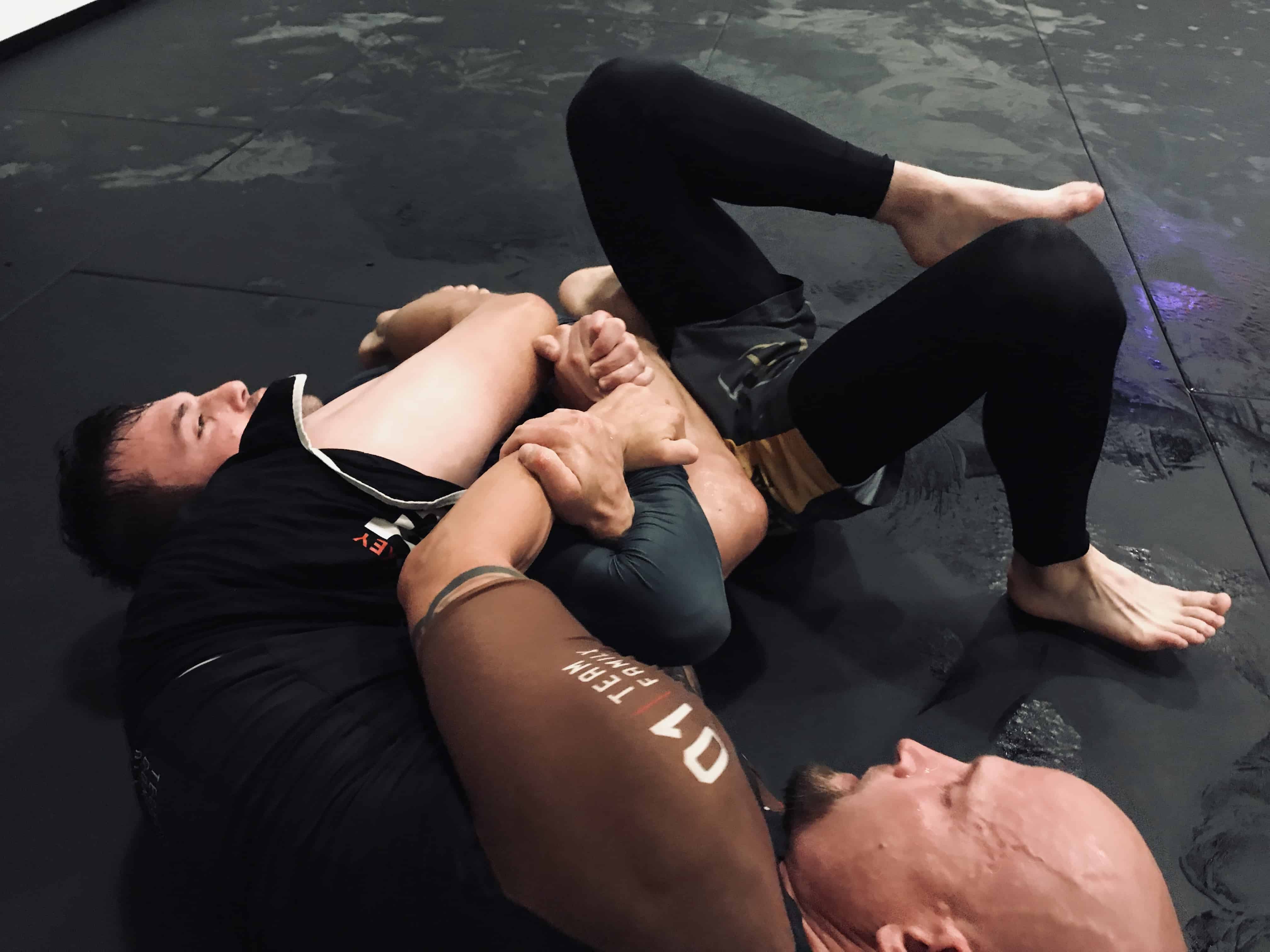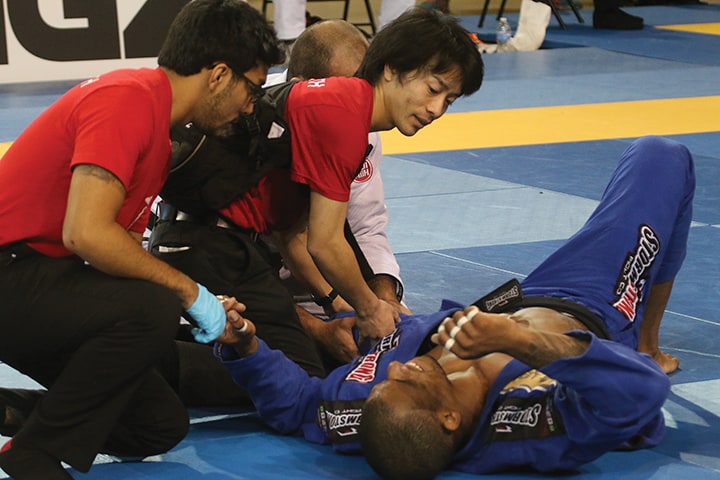Injuries in Jiu-Jitsu
The Truth of Injury
Jiu-Jitsu is a combat sport. It is one of the most intense physical activities one can engage in. The physical exercise it provides can be incredibly beneficial to the human body, not to mention the mind and spirit. However, like any strenuous activity, wear-and-tear and traumatic injury do occur. Common minor injuries in Jiu-Jitsu include jammed fingers and toes, bruised or “separated” ribs, and minor strains of the back, hips, knees, ankles, elbows, and shoulders. However, more serious injury does occur, although it isn’t as common as the aforementioned injuries. If you train with the regularity and intensity required to progress and succeed in the art and sport of Jiu-Jitsu, it is not a matter of if – merely a matter of when and to what severity – you will become injured.

That being said, the Jiu-Jitsu mats aren’t a battlefield replete with casualties and broken bodies. There is a healthy and safe way to train Jiu-Jitsu consistently and with intensity. There are steps that one can take to minimize the risk and severity of injury, as well as actions one can take – and foresake! – in order to ensure a full recovery.
Goals and Roadblocks
As students of Jiu-Jitsu our primary goal is to always maximize our time spent on the mats practicing, drilling, rolling, and competing. Injury prevents us from doing this, and also prevents us from living healthy and flourishing lives off the mats. As a result, we want to reduce the time we spend injured to an absolute minimum. This leads us to a quandary: our primary goal is to train as much as possible, so we will often internally minimize the severity of our injuries in order to justify maintaining our normal training schedules. Doing this will often (but not always!) cause us to take even more time off the mats. Training while one is mildly injured might seem a good idea: why take time off the mats when it may not be 100% necessary to do so? This can sometimes be true, but it often causes us to take more time off the mats than if had we listened to our bodies and reduced the intensity of our training – or stopped completely while taking the time to allow our bodies to heal.

In an well-intentioned attempt to encourage participation, retention, and motivation to train, new students of Jiu-Jitsu often aren’t told of the risk of injury. Because of this, they usually remain ignorant of how to minimize the risk of injury or what they should do to continue to improve in Jiu-Jitsu after they have been injured.
The Rules of Recovery
Through much trial-and-error, stubbornness, injury, re-injury, rehab, and recovery, I have found these general guidelines to be the best to follow to prevent and heal injuries in Jiu-Jitsu:
1. Listen to your body.
Don’t ignore “minor” aches and pains. This doesn’t mean you need to stop training as soon as you strain your shoulder or jam your finger. The human body is remarkably resilient, and one of the most beneficial and revelatory realizations you will have when you start training Jiu-Jitsu is that you aren’t made of glass. You will come to learn that you are stronger and tougher than you give yourself credit for. A little bit of grit goes a long way in Jiu-Jitsu. However, you should be mindful of these trouble areas in your body, and be sure to assess whether they are improving or getting worse.
2. Don’t train (hard).
When you have determined that you are sufficiently injured to the point that it is effecting your daily life and/or training, you should stop sparring/rolling – or at the very least, stop rolling hard. This does not mean that you should stop showing up to class. This is a great time to work on actively learning and refining technique. Your injury may be a blessing in disguise and a not-so-subtle sign that you are tipping the ratio of rolling:drilling/repping a bit too much. Utilize this time spent not rolling to get a lot of quality reps in. Focus on slow, measured, and intentional movement. If you are unable to rep you can still elect to your gi on, come to class, and observe the techniques of the day and maybe even help others if you are an upper belt. Every minute you spend on the mats can be of value to yourself and/or your training partners.
3. Seek medical attention.
Every Jiu-Jitsu practitioner thinks they know exactly how to heal the injury that you have. Most of us have all suffered the “same” injury: shoulders, knees, back, neck, you name it. However, every body is different and every injury is different. Your training partners don’t have X-Ray machines and MRIs for eyeballs. They aren’t medically trained professionals (unless, of course, they are). Everybody wants a quick and cheap fix, a DIY folk remedy, or some sort of “hack” to heal an injury. This is not the path you want to take if you are looking to heal real physical injuries sustained on the mats. You should seek medical attention and take the advice of your doctor or another healthcare professional such as a physical therapist. The road to recovery can be long and arduous. Often our injuries occur as a result of years of wear-and-tear, and as it takes that long to sustain an injury, so the road to recovery won’t be quick. But it will be much longer and harder if you don’t seek the proper care for your injuries. Physical therapy and professional medical attention in the early stages of an injury can be far less expensive and time-intensive than waiting until you sustain a traumatic injury that requires surgery or months of slow and boring rehab. Which brings me to the next rule.

4. When returning to the mats, start slow.
You just took some time off the mats due to an injury, maybe even a considerable amount of time. Don’t expect that you will immediately be able to train like you did prior to your injury. Start with light movements without any resistance to warm up your body, and if you feel up to it you can do light repping and drilling. When you return to rolling, you should do so with partners whom you can trust to roll light(er) and understand how to roll with a person recovering from an injury. If all of the above feels okay, do not assume you are fully healed and resume full-intensity training. Slowly increase the intensity over time. If you feel any discomfort or return to injury, put the brakes on. The more gradual your return, the longer you will be able to stay on the mats at 100% capacity. Patience is a virtue!
5. Find out what training habits you have that may lead you to become injured, and avoid them.
Personally, I have always sustained injury when I skip or half-ass warmups. I also have developed a bad habit of allowing myself to be comfortable in bad (contorted) positions. I also prefer playing on the bottom of open guard, which often leads to my legs being entangled, my spine contorted, and being stacked and inverted. This, over a long period of time with little variety in training, led to some moderate-to-severe muscular imbalances, weaknesses, and subsequent injury. Incidentally the bad habits that led to my injury are also bad for my Jiu-Jitsu! We should strive to be healthy and well-rounded practitioners of Jiu-Jitsu. Don’t get stuck in bad patterns that lead to injury! Assess how the way you train and play Jiu-Jitsu might not be the best for your body. Add more variety to your training to avoid constant wear-and-tear on specific part of your body, a bonus is that this will also make you a more well-rounded student of the art.
6. Commit to a rehab/prehab program.
Jiu-Jitsu is an intense sport and practice. A lot of us thrive on that intensity. It may be one of the things that attracted us to Jiu-Jitsu in the first place. Rehab/prehab routines – on the other hand – aren’t fun, intense workouts. They are often very boring, especially for those of us who are used to trying to choke and armlock people and prevent them from doing the same for us. While rehabbing or prehabbing, it is important that you keep in mind that you are taking small steps towards a large goal: a healthy body that enables you to train Jiu-Jitsu consistently and with intensity. You should have a daily routine that you adhere to that addresses your various trouble-spots. Ideally this routine should be prescribed to you by a healthcare professional. I try and do the same yoga sequence every single day. It takes ten minutes of my time, twice a day. That’s not a lot to ask for being able to train Jiu-Jitsu every day, pain-and-injury free.
Disclaimer
That’s it! When I have become injured it is usually because I have broken one of these rules. However, I am not a healthcare professional (see rule #3!). If you or any other person has a medical concern, you should consult with your health care provider or seek other professional medical treatment. Never disregard professional medical advice or delay in seeking it because of something that you have read on this blog or in any linked materials. If you think I missed any important tips for avoiding and healing injuries in Jiu-Jitsu, let me know in the comment section below!
See you on the mats!